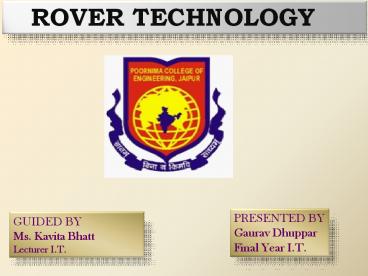ROVER TECHNOLOGY - PowerPoint PPT Presentation
Title:
ROVER TECHNOLOGY
Description:
... A location determination phase. ... following three ... 6 Slide 7 Slide 8 ROVER CONTROLER Slide 10 ROVER DATABASE Slide 12 Slide 13 SERVER ... – PowerPoint PPT presentation
Number of Views:3701
Avg rating:3.0/5.0
Title: ROVER TECHNOLOGY
1
ROVER TECHNOLOGY
PRESENTED BY Gaurav Dhuppar Final Year I.T.
GUIDED BY Ms. Kavita Bhatt Lecturer I.T.
2
CONTENTS
- Introduction
- Rover Services
- Location Sensing technologies
- Rover Architecture
- Rover Servers
- Action Model
- System Functionality
- Multi-Rover System
- Rover Clients
- Conclusion and Future Works
- References
3
ROVER TECHNOLOGY
- INTRODUCTION
- Location - aware, Time-aware, User-aware, and,
- Device-aware.
- This involves automatic tailoring of
information - and services based on a current location of
the - user.
- The user make avail location-aware computing
- through his PDA (Personal Digital
Assistance) or - any handheld devices.
4
ROVER SERVICES
- BASIC DATA SERVICES
- TRANSACTIONAL SERVICES
- MAP-BASED SERVICES
- FILTER
- ZOOM.
- TRANSLATE
5
LOCATION-SENSING TECHNOLOGIES
- COARSE GRAINED SYSTEMS
- Accuracies on the order of meters.
- Suitable for outdoor areas.
- FINED GRAINED SYSTEMS
- Accuracies on the order of centimeters.
- Suitable for both (indoor and outdoor areas)
with higher - accuracies.
- SENSOR FUSION
6
DEPLOYMENT OF LOCATION SENSING TECHNOLOGIES
7
ROVER ARCHITECTURE
- End Users
- Rover Clients
- Wireless access infrastructure
- Servers (manage and implements services provided
to users) - Servers consists of the following -
- Rover Controller
- Location Server
- Media Streaming Unit
- Rover Database
- Logger
8
Physical architecture of Rover System
9
ROVER CONTROLER
Servers
- Rover controller interacts with other
components of the system through the following
interfaces- - Location Interface
- Admin Interface
- Content Interface
- Back-end Interface
- Server Assistants Interface
- Transport Interface
10
Logical architecture of Rover System
11
ROVER DATABASE
Servers
- 1) User info base-
- Maintains user and device info with
- Volatile data and Non-volatile data
- 2) Content Info base-
- stores content served by the controller.
- 3) Transactions of rover controller with database
from server operation are done by- - lock-acquiring and blocking flags
- for avoiding deadlock.
12
LOCATION SERVER
Servers
RADIO MAP TECHNIQUES
- Works in 2 phases
- Offline phase.
- Signal strength to vectors.
- 2)A location determination phase.
- Vector sample compared with the radio-map.
MODEL BASED TECHNIQUES
Signal strength received from each access point
is transform in function of distance.
13
ACTION MODEL
- Allows Rover systems to scale to large user
populations by allowing real-time application
specific scheduling of tasks. - Scheduling is done in atomic units called
actions. - An action is a small piece of code
- All actions are executed in a controlled manner
by the Action Controller. - The action is executed whenever an I/O response
is received.
14
SERVER OPERATION
ACTION MODEL
- A SERVER OPERATION IS A SEQUENCE OF
- ACTIONS.
- Server operation refer to a transaction that
- interacts with the rover controller.
- Each server operation has exactly one
- response handling action for handling
- I/O event responses for the operation.
15
ACTION MODEL
SERVER OPERATION
- A Server operation is in one of the
following three states. They are- - Ready-to-run At least one action is eligible to
be executed but no action is executing. - Running One action is executing
- Blocked Server operation is waiting for some I/O
response.
16
ACTION MODEL
- ACTION CONTROLLER uses administrator defined
policies for - scheduling of actions.
- Management and execution of actions -
- Init(action id, function ptr)
- Run(action id,function parameters, deadline
failed handler - ptr)
- Cancel(action id,cancel handler ptr)
17
ACTION MODEL
ACTION VS THREADS
Our need to scale to very large client
populations made us adopt the action model rather
than the more traditional thread model.
18
Scenario A has 10,000 processor-bound server
operations where computation is interleaved with
file write operations
Scenario B has 100 I/O bound server operations
where computation is interleaved with network I/O
interactions
19
SYSTEM FUNCTIONALITY
System Admin Operations
User Access Operations
Query Operations
Location Update Operation
Audio Chat Operations
20
MULTI-ROVER SYSTEM
- The multi-rover system is a collection of
independent rover systems that peer with each
other to provide the seamless connectivity to the
users. - The design of a multi-rover system is similar to
the Mobile IP solution to provide network
mobility to devices.
21
ROVER DEMO
22
iPAQ Rover Client
23
Conclusion Future Works
- The short and long term projects of this
paradigm- - Experiment with limited capability devices
- Location aware Streaming Devices
- Interact with cellular providers and implement
this mechanisms on cellular interface. - Multi-Rover System
24
REFERENCES
- http//www.bluetooth.com.
- http//www.irda.org.
- http//www.wikipedia.org/Rover_technology.
- P. Bahl and V.N. Padmanabhan. RADAR An
in-building RF-based user location and tracking
system. In Proceedings of Infocom, Tel Aviv,
Israel, March 2000. - N. Davies, K. Cheverst, K. Mitchell, and A.
Efrat. Using and Determining Location in a
Context sensitive Tour Guide. IEEE Computer,
34(8), August 2000. - B. Hofmann-Wellenhof, H. Lichtenegger, and J.
Collins. GPS Theory and Practice.
Springer-Verlag,Wein, NY, 1997. - IEEE. Wireless LAN medium access control (MAC)
and physical layer (PHY) specification, Standard
802.11, 1999. - A.J. Viterbi. CDMA Principles of Spread Spectrum
Communications
25
QUESTIONS ??
26
THANK YOU































